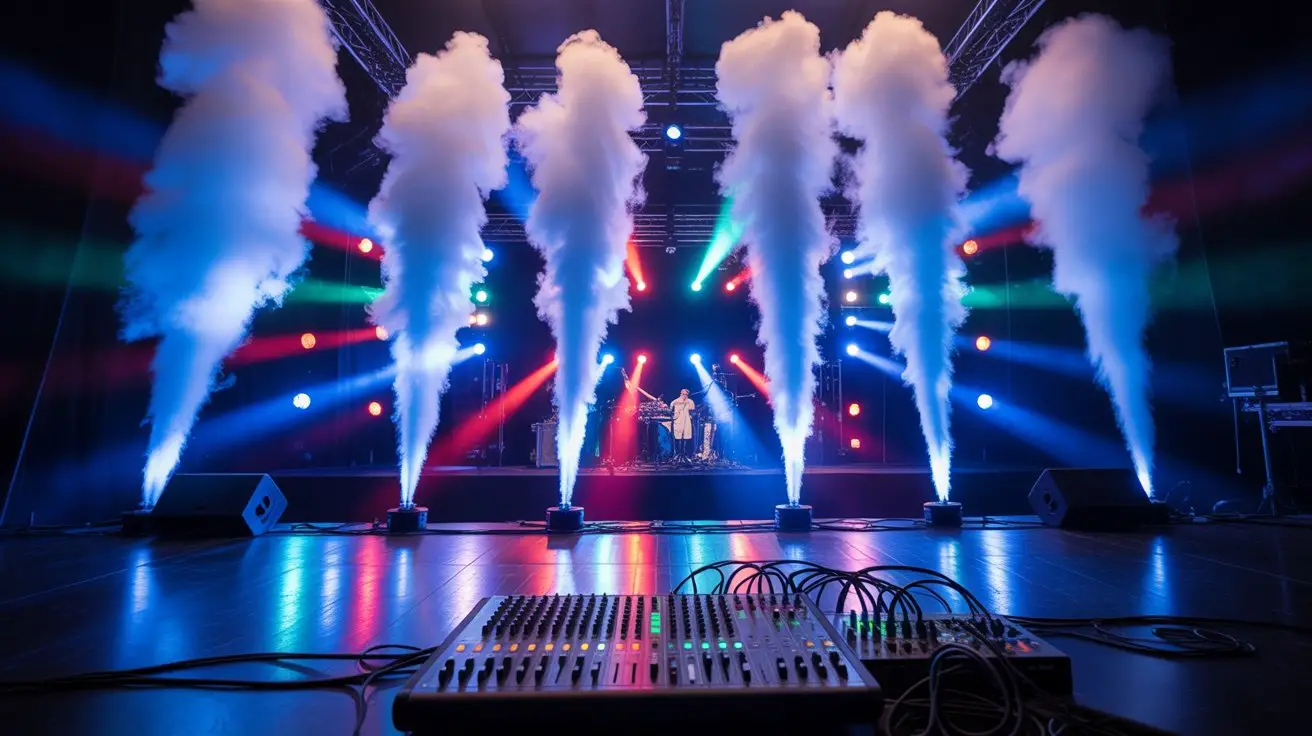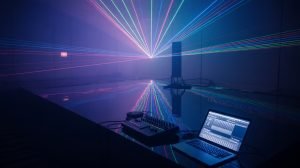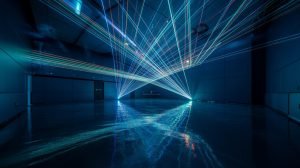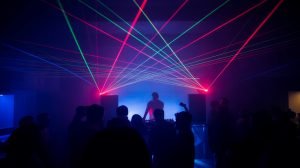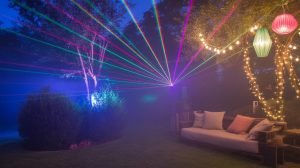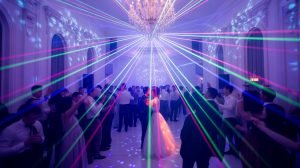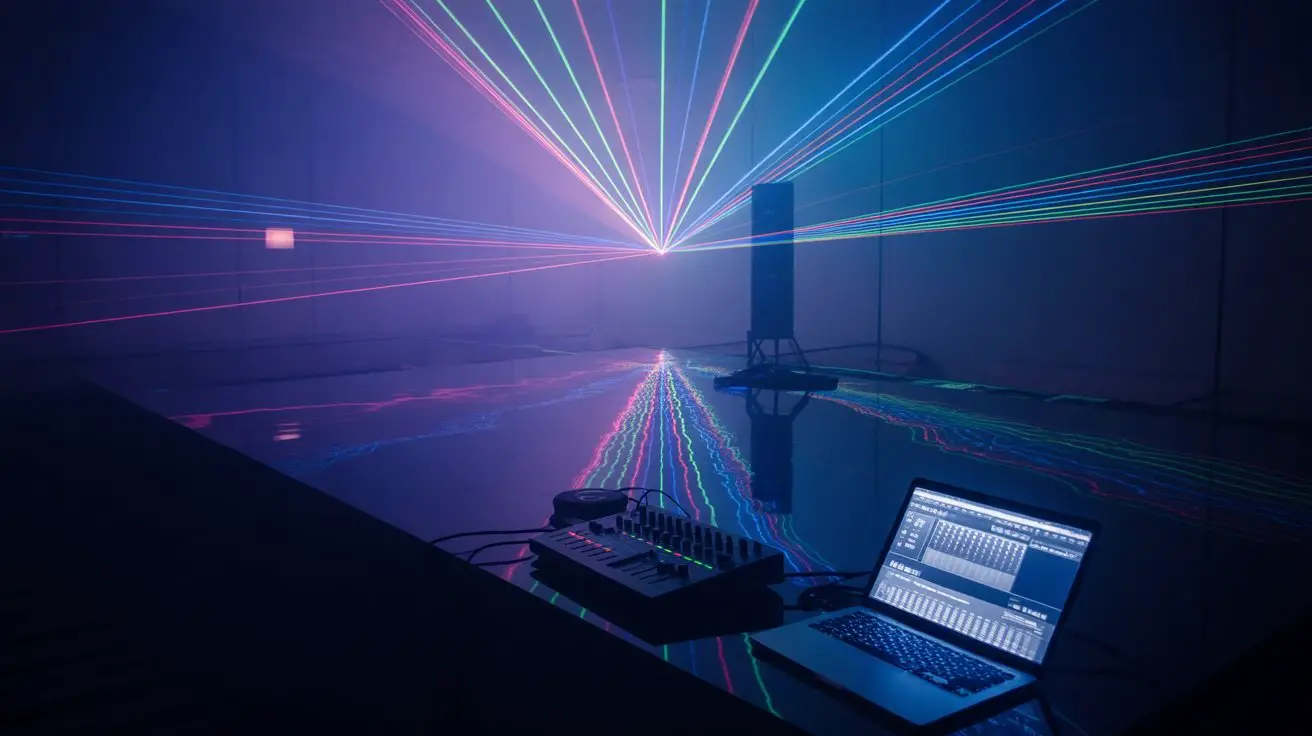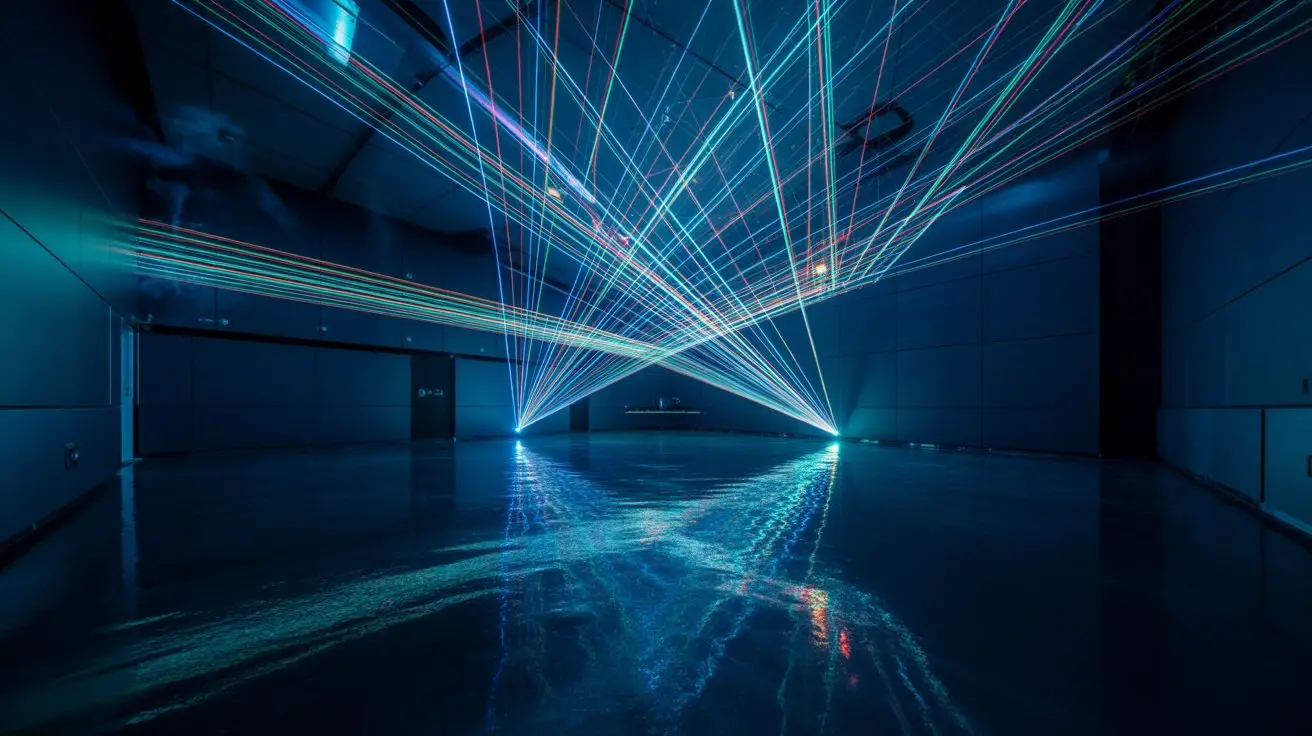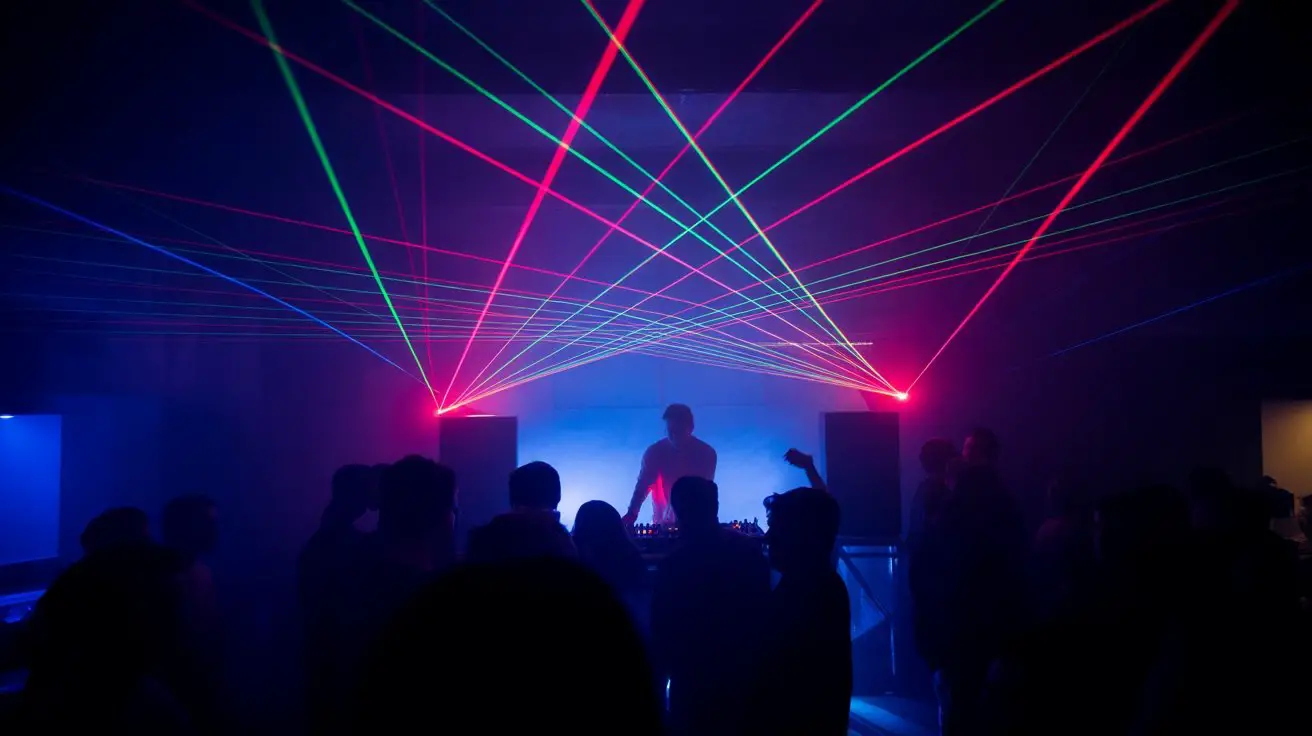You’re standing in front of your fog machine, watching vapor drift aimlessly across the stage while your carefully curated soundtrack pulses through the speakers—completely out of sync. The secret lies in understanding how DMX controllers translate audio signals into precise timing commands, transforming random fog bursts into choreographed atmospheric effects. Your choice between audio-reactive triggers, manual programming, or automated software will determine whether your fog becomes an integral part of the performance or simply background haze that misses every vital beat drop.
Essential Equipment for Music-Synchronized Fog Effects
Your signal chain requires XLR cables for DMX transmission and audio splitters to maintain clean signal paths.
A dedicated audio interface guarantees low-latency processing between your music source and fog triggers.
Consider investing in haze machines for sustained atmospheric effects or burst-style foggers for dramatic peaks.
Professional setups benefit from backup controllers and redundant cabling to prevent mid-show failures during critical musical moments. Additionally, be aware that fog machines can trigger fire alarms due to smoke particles, so it’s essential to check the type of smoke detectors present in the venue.
Understanding DMX Controllers and Audio-Reactive Systems
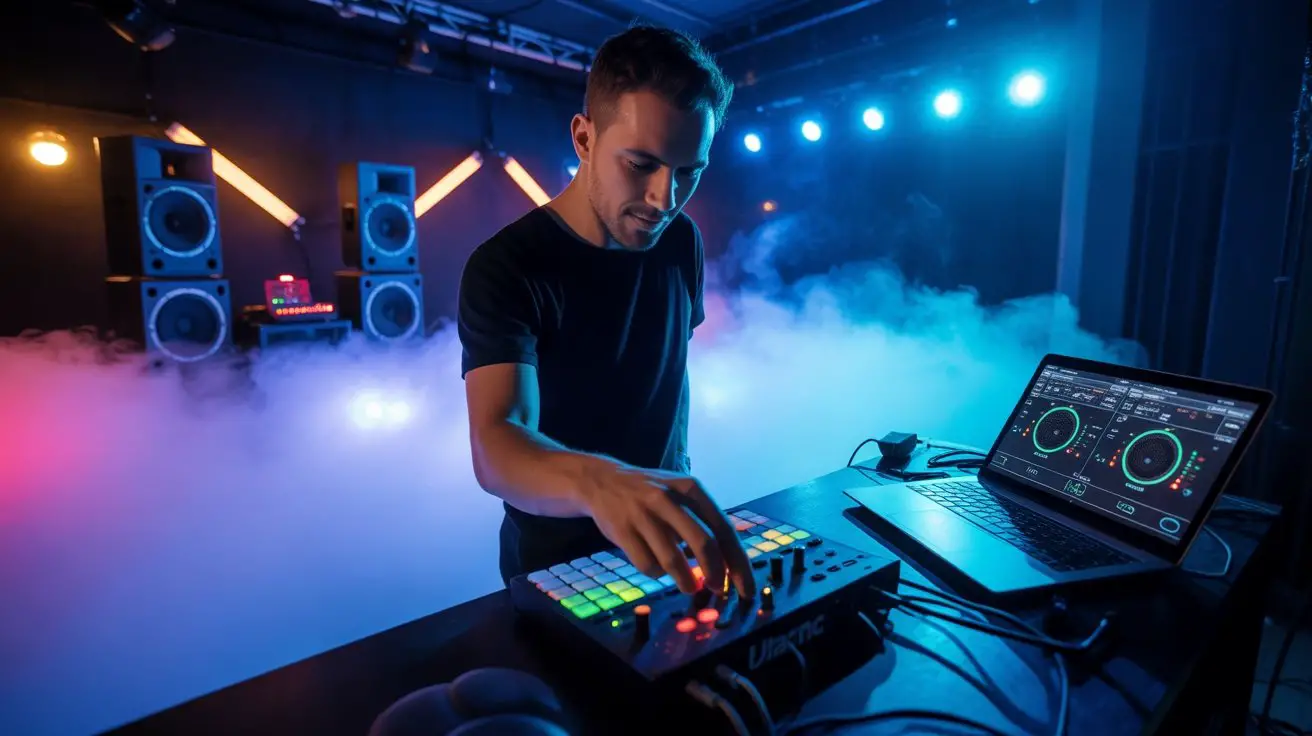
While DMX controllers serve as the digital backbone of your fog synchronization system, they translate musical data into precise lighting protocol commands that trigger your fog machines at exact millisecond intervals.
You’ll configure channels to map specific frequency ranges—bass drops, snare hits, or vocal peaks—to individual fog outputs.
Audio-reactive systems analyze incoming sound through built-in microphones or direct audio inputs, converting amplitude and frequency data into DMX signals.
Your controller’s sensitivity settings determine trigger thresholds, while fade times control fog burst duration.
Advanced units offer programmable scenes that layer multiple fog patterns with beat detection algorithms.
Connect your fog machines to DMX addresses, then calibrate audio input levels to prevent false triggers from ambient noise.
Manual Timing Techniques for Basic Synchronization
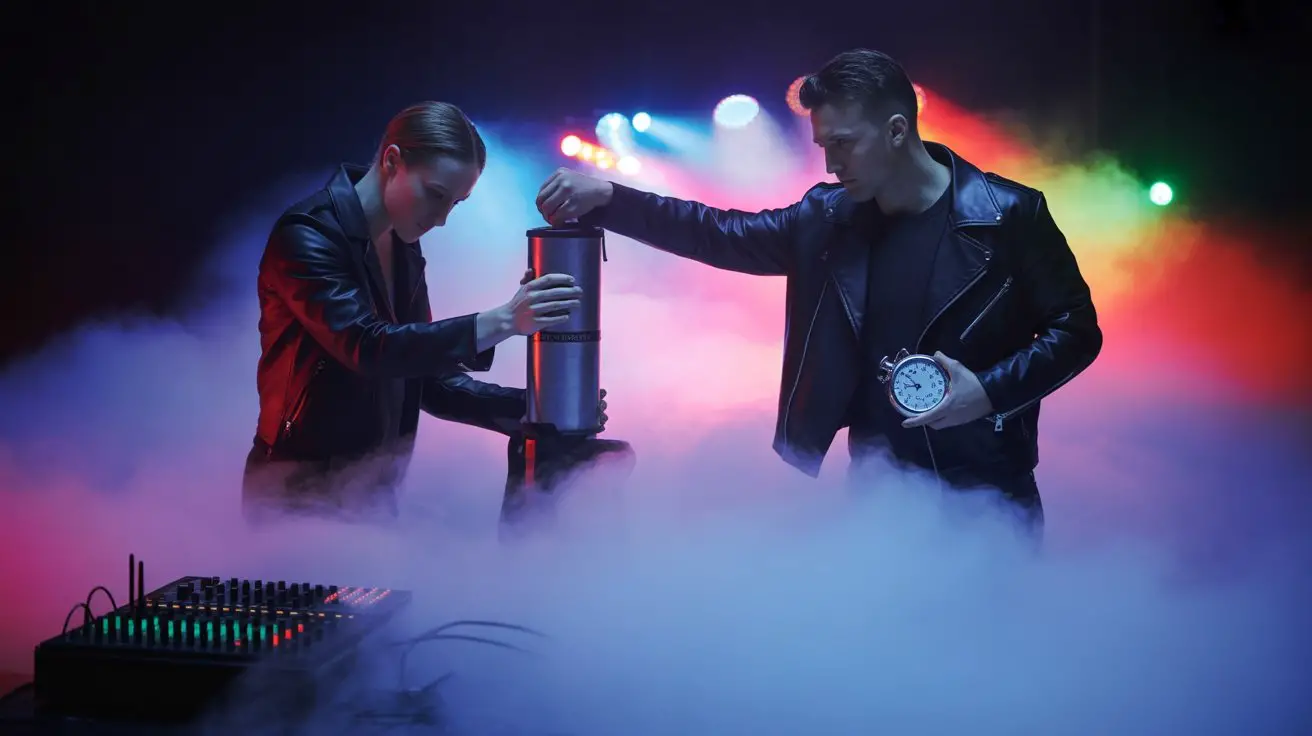
When DMX systems aren’t available, manual timing becomes your primary method for creating synchronized fog effects that match musical dynamics. You’ll need to pre-analyze your track, marking beat patterns, crescendos, and dramatic breaks on paper or digital timeline.
Position your fog machine’s manual trigger within arm’s reach, ensuring clear sightlines to both your music source and performance area.
Practice activating fog bursts 1-2 seconds before desired visual impact, compensating for machine warm-up and fog dispersion delay. Short pulses create accent effects during percussion hits, while sustained releases build atmospheric layers during melodic sections.
Monitor fog density continuously—overdoing effects muddles your synchronization efforts. Use a metronome during rehearsals to internalize timing patterns, then rely on musical intuition during live performances for organic, responsive fog choreography. Additionally, be cautious of fog machine health hazards as prolonged exposure can lead to respiratory issues, especially for sensitive individuals.
Setting Up Audio Trigger Systems
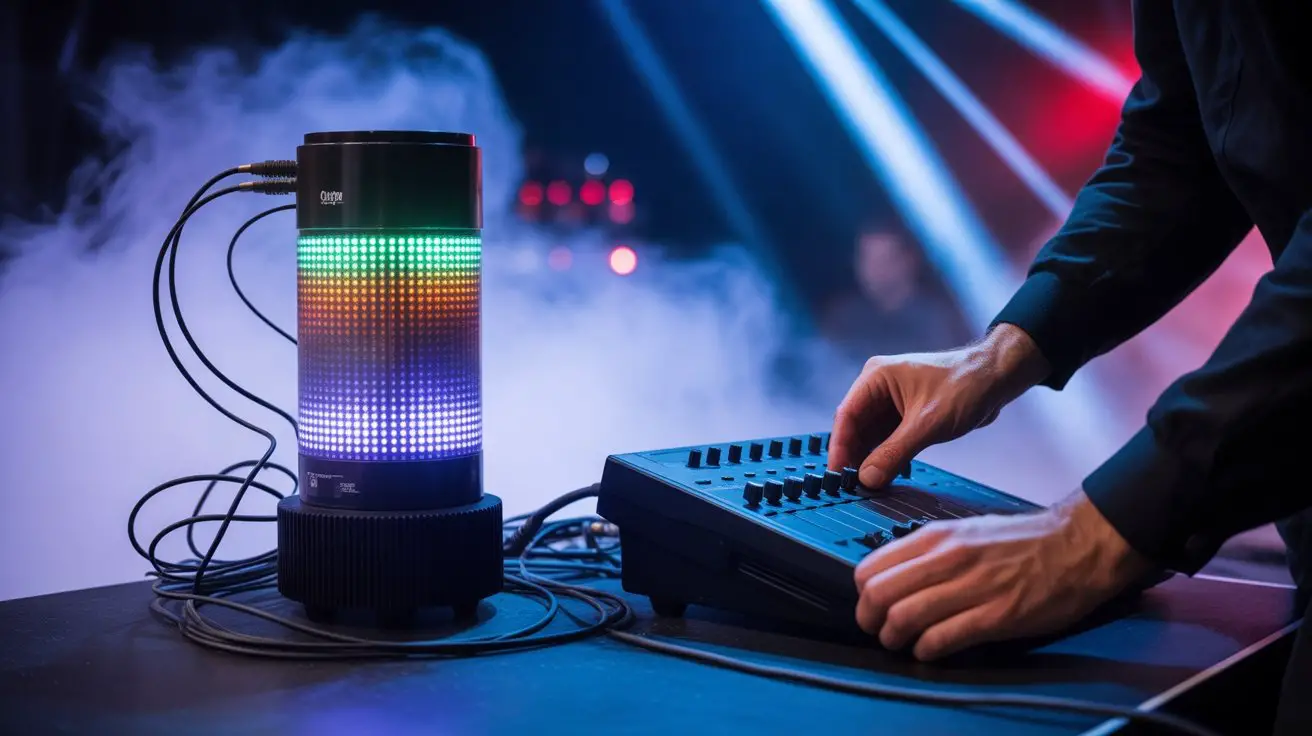
Audio trigger systems transform sound waves into electrical signals that automatically fire your fog machine, eliminating guesswork from manual timing.
You’ll need an audio-to-relay converter, typically featuring a microphone input and adjustable sensitivity controls. Connect your music source directly to the trigger unit’s audio input or position its built-in microphone near your speakers.
Set the sensitivity threshold by adjusting the potentiometer while playing your target music. Lower settings respond only to loud beats, while higher settings trigger on subtle musical elements.
Wire the relay output to your fog machine’s remote control terminals, creating an automated firing circuit.
Test different threshold levels with various songs to find your sweet spot. The system will now detect audio peaks and instantly activate your fog machine, creating perfectly timed atmospheric effects that pulse with your music’s rhythm.
Advanced DMX Programming for Professional Results
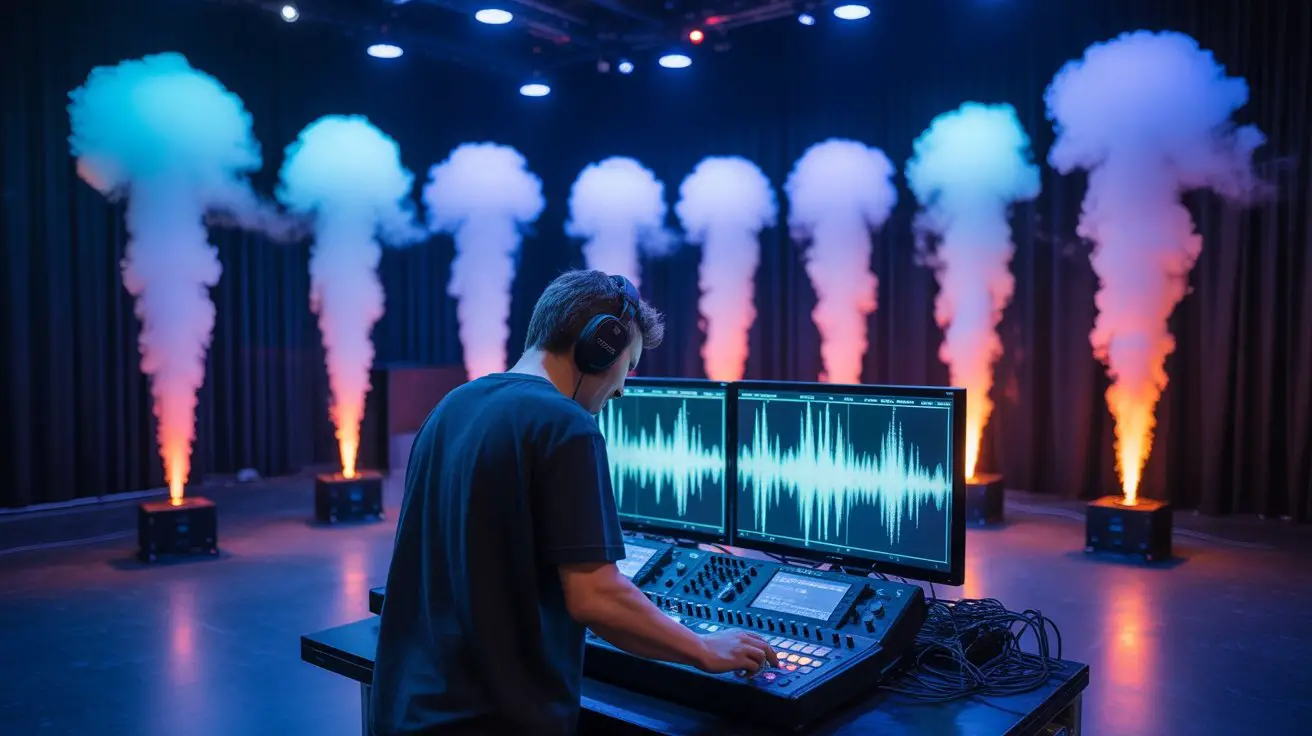
Since professional lighting systems demand precise synchronization across multiple devices, DMX512 protocol becomes your primary tool for orchestrating complex fog machine sequences. You’ll assign unique DMX addresses to each fog machine, typically starting with channel 001 for your primary unit. Program intensity curves that mirror your music’s dynamics—gentle swells during verses, explosive bursts at drops. Use your console’s timeline editor to pre-program cue sequences, matching fog density to musical phrase lengths. Link multiple machines through daisy-chained XLR cables, ensuring proper termination with 120-ohm resistors. Advanced consoles let you create chase patterns where fog machines trigger sequentially, creating rolling cloud effects across your stage. Map MIDI timecode to DMX triggers for frame-accurate synchronization with backing tracks. Additionally, incorporating multiple control options from fog machines can enhance your overall setup flexibility.
Choosing the Right Fog Machine for Musical Applications
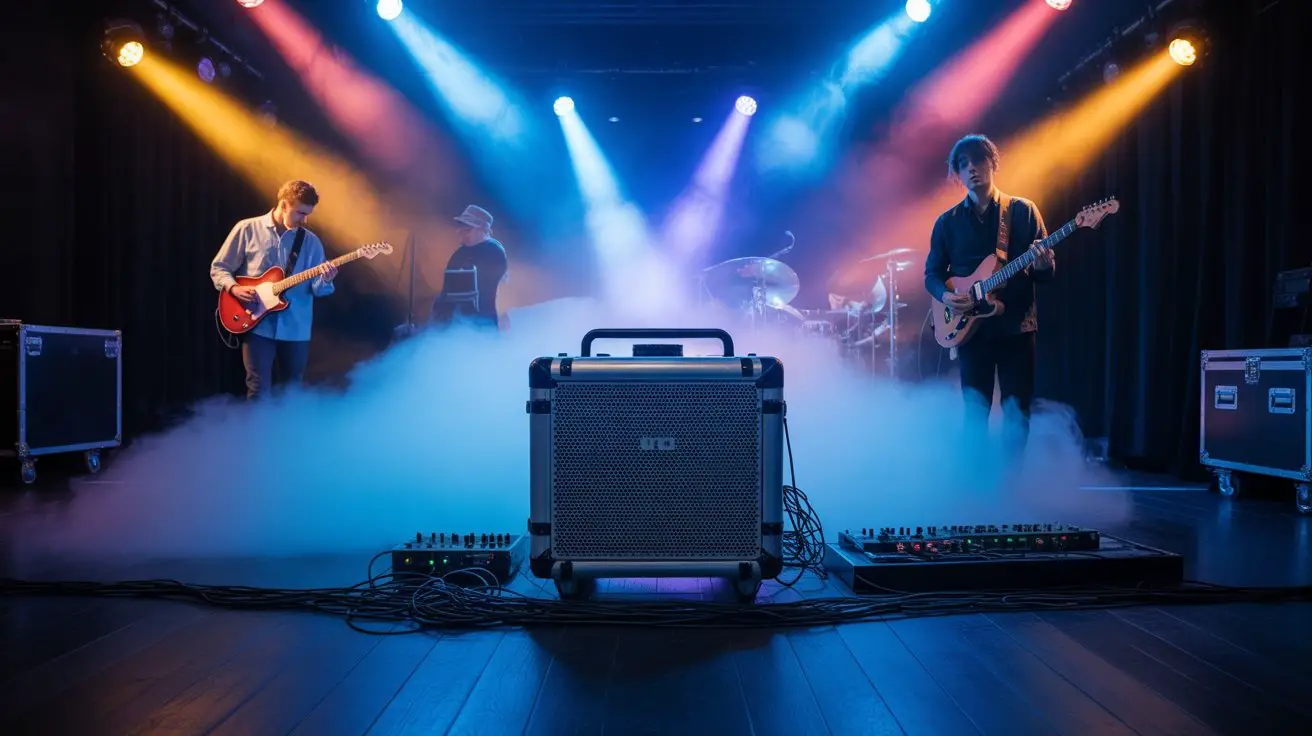
The heart of any music-synchronized fog system lies in selecting machines that match your venue’s acoustics and visual requirements.
You’ll need machines with rapid response times and precise output control to achieve seamless integration with musical dynamics.
Consider these essential specifications when selecting your fog machine:
- Output Volume Control – Variable intensity settings from 0-100% allow precise matching to musical crescendos and quiet passages.
- Heat-Up Time – Professional units with 2-3 minute warm-up periods guarantee consistent performance throughout your event.
- DMX Compatibility – 512-channel protocol support enables complex programming sequences synced to audio triggers.
- Fluid Consumption Rate – Calculate venue size against machine capacity to maintain continuous operation during extended performances.
Match your machine’s technical capabilities to your venue’s cubic footage and desired visual impact density for best results. Additionally, ensure that the machine uses water-based fog fluids, as they produce non-toxic fog that dissipates quickly and is safe for indoor use.
Software Solutions for Automated Light and Fog Shows
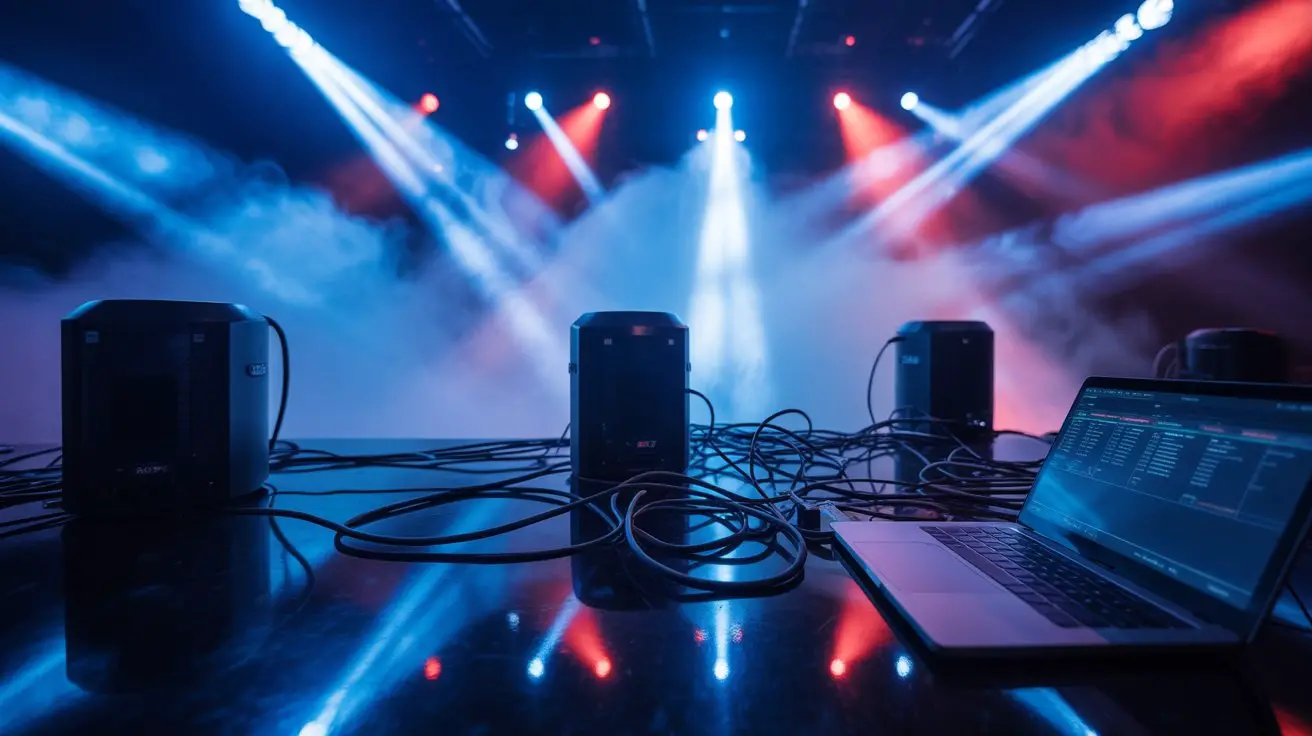
Once you’ve selected your fog machine, software becomes your command center for orchestrating synchronized performances that respond to every beat and musical nuance.
Professional DMX controllers like Chamsys MagicQ and GrandMA3 onPC offer precise timing control through MIDI integration. You’ll program cues that trigger fog bursts during crescendos and atmospheric layers during quieter passages.
For budget-conscious setups, consider Freestyler DMX or QLC+, which provide essential synchronization features without licensing costs. These platforms analyze audio frequencies in real-time, automatically triggering effects based on bass drops, vocal peaks, or custom threshold settings.
Advanced software like Resolume Arena combines video mapping with fog control, creating immersive environments where visual elements complement atmospheric effects.
Configure your software to read BPM data, enabling seamless shifts that maintain perfect synchronization throughout your performance.
Troubleshooting Common Synchronization Issues
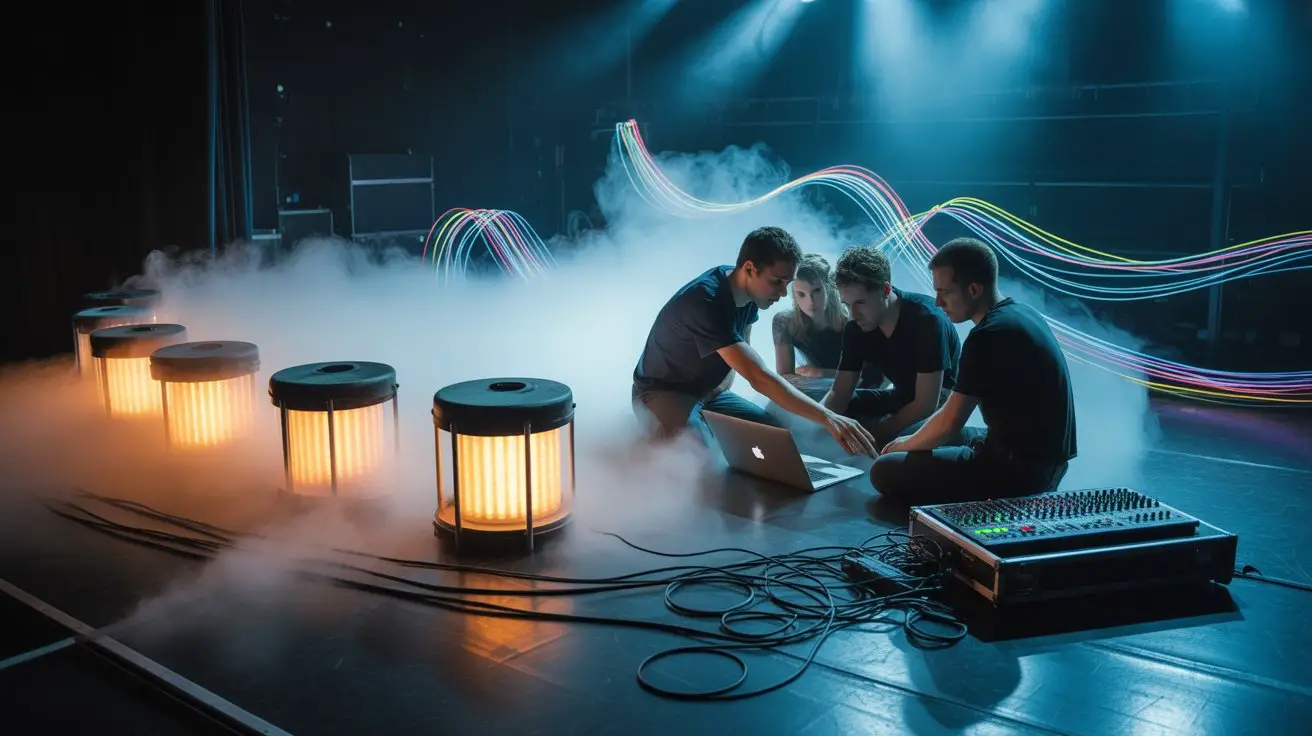
Even with meticulously programmed software, you’ll encounter timing delays that throw your fog effects off-beat by several milliseconds.
Signal latency between your audio interface and fog machine creates the most frustrating synchronization problems. Your DMX controller might process commands slower than expected, while wireless transmissions add unpredictable delays.
When troubleshooting these issues:
- Calibrate timing offsets by measuring your system’s actual response time using oscilloscope readings or audio analysis software.
- Check DMX cable integrity for loose connections, damaged pins, or excessive cable runs beyond 500 feet.
- Monitor fluid temperature since cold fog juice increases machine warm-up time and reduces output consistency.
- Isolate power supplies to prevent voltage drops that cause erratic machine behavior during peak fog output. Regular cleaning and maintenance of your fog machine can also help prevent synchronization issues.
Frequently Asked Questions
Is Fog Machine Synchronization Safe for Indoor Venues With Smoke Detectors?
You’ll trigger smoke detectors with fog machines since most can’t distinguish between smoke and fog particles. You must disable detectors temporarily, notify building management, and guarantee proper ventilation systems operate throughout your event.
How Much Does a Basic Music-Synchronized Fog Setup Cost for Beginners?
You’ll spend $150-400 for entry-level synchronized fog systems. Basic setups include sound-activated fog machines ($80-150), manual controllers ($30-80), and fog fluid ($20-40). DMX-compatible units cost more but offer precise timing control.
Can Fog Machines Damage Musical Instruments or Electronic Equipment Nearby?
Picture fog as invisible water droplets settling like morning dew on circuits. You’ll risk moisture damage to electronics, corroded contacts, and short circuits. Position instruments away from direct fog output and use protective covers for sensitive equipment.
What Fog Fluid Types Work Best for Music Synchronization Applications?
You’ll want water-based fog fluids with consistent viscosity for precise timing control. Medium-density formulations respond predictably to heat triggers, while quick-dissipating types work best for rapid beat synchronization and crisp visual effects.
Do I Need Special Permits for Using Synchronized Fog Machines at Events?
You’ll need permits for most commercial venues and outdoor events. Check local fire codes, venue restrictions, and noise ordinances. Indoor theaters often require additional safety clearances. Contact your fire marshal before installing synchronized equipment systems.
Conclusion
You’ve mastered the technical symphony where fog machines dance with sound waves, transforming your venue into a mesmerizing landscape. Your DMX controllers now pulse like electronic heartbeats, triggering ethereal clouds that billow precisely with each bass drop. The marriage of audio triggers and professional-grade equipment creates atmospheric theater that captivates audiences. Your fog bursts cascade through spotlights like liquid smoke, perfectly choreographed to music’s rhythm, elevating performances from ordinary to extraordinary visual spectacles.

